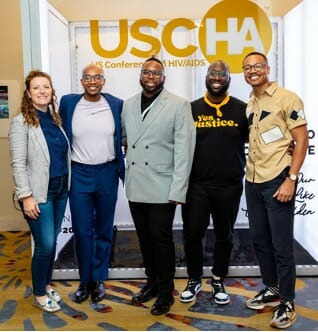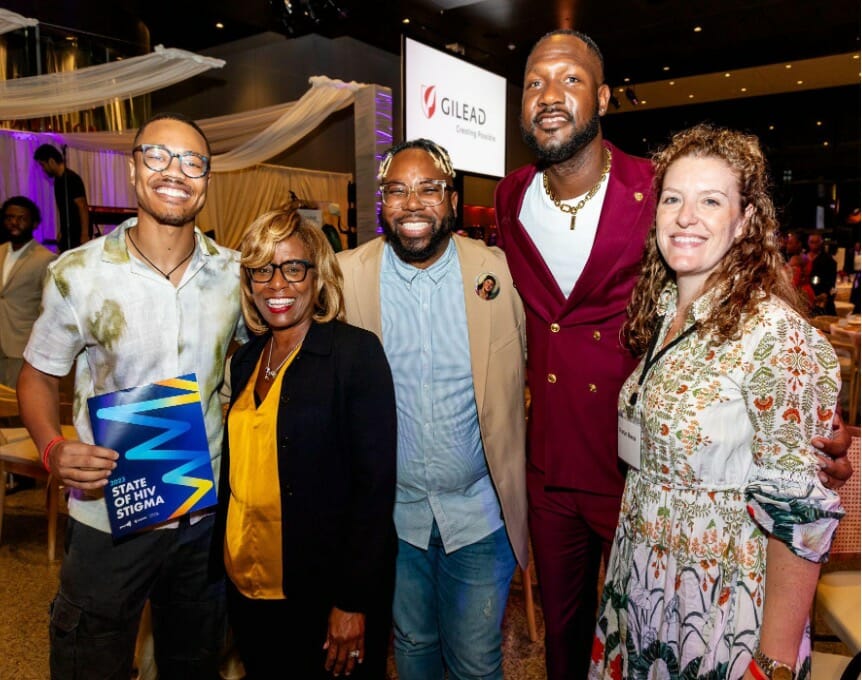The GLAAD Media Institute’s Tristan Marra, Vice President Research & Reports, DaShawn Usher, Director, Communities of Color, and Julian J. Walker, Associate Director Communities of Color, were on the ground for the 27th Annual United States Conference on HIV/AIDS in Washington DC on September 8th to present the latest findings from GLAAD’s 2023 State of HIV Stigma Report.

The conference theme this year was “A Love Letter to Black Women,” to emphasize just how important all Black women, cisgender and transgender are to the movement, our society, and the nation as a whole.

GLAAD’s GMI team engaged with USCHA attendees and handed out nearly 500 hard copies of the fourth annual State of HIV Stigma report.





Tristan Marra and DaShawn Usher lead a presentation entitled, Leveraging Media Advocacy in the Fight Against HIV Stigma in alignment with GLAAD’s fourth annual State of HIV Stigma report in partnership with Gilead Sciences and the Gilead COMPASS Initiative®.


Damon L. Jacobs – Licensed Marriage and Family Therapist and HIV prevention specialist engaging during the presentation
The HIV stigma study was created in partnership with Gilead Science and the Gilead COMPASS Initiative® (COMmitment to Partnership in Addressing HIV in Southern States). The GMI team discussed data tracking Americans’ attitudes and knowledge about HIV and the stigma surrounding it:
- 86% of Americans surveyed say there is still a stigma around HIV.
- Only 3% say they are not aware of HIV.
- For the second consecutive year, more Americans are aware that there are medications (like PrEP) that can protect against contracting HIV.
- For the first time, the study noted an alarming generation gap. 62% of GenX (born between 1965 and 1980, who came of age in the early days of HIV) say they are knowledgeable about HIV compared to 34% of GenZ (born between 1997 and 2012).

There was active discussion and questions from the audience around the generational knowledge gap between Gen Z adults and Gen X when it comes to knowledge of HIV. GenZ is also the most out LGBTQ generation in history, with about 20% out as LGBTQ. People ages 13 to 34 account for 57% of new HIV diagnoses, according to HIV.gov.

“We urgently need to accelerate bridging all the gaps — generational, knowledge, empathy and understanding — to end HIV,” GLAAD President and CEO Sarah Kate Ellis noted in her introduction to the report.
“We must tap the talents and conscience of all generations, especially Gen Z, and engage their proven commitment to racial justice, LGBTQ equality and diversity in all forms, as well as to the environment, and to our democracy. Attention in all of these areas is crucial to ending HIV.”
The report and presentation detailed the impact that authentic storytelling and visibility of characters living with HIV have on perceptions and attitudes around HIV stigma. 30% of Americans say they have seen people living with HIV on TV, followed by 19% who saw people living with HIV in movies.

A highly engaged audience of about 80 people attended the presentation and panel discussion that followed.


DaShawn Usher led a Q&A session featuring Marvell L. Terry II (Founder, Saving Ourselves Symposium, Cultural Organizer, Activist, and Leader) and Joshua Mackey (Editor, Writer, Culture/Film/TV Critic – INTO Magazine) to explore ways to work with the media to advance accurate and inclusive stories about HIV and people living with HIV to eradicate HIV stigma in every community.



Having easily accessible information about HIV available in schools is of high importance to Americans. 85% agree HIV information should be easily accessible in the community. 91% agree HIV should be taught in schools.

These numbers have remained high year over year, pointing to a desire to have information available on HIV to close the knowledge gap.
Read GLAAD’s State of HIV Stigma Study in its entirety here.













